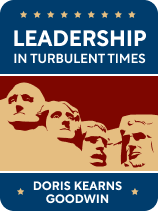

This article is an excerpt from the Shortform book guide to "Leadership: In Turbulent Times" by Doris Kearns Goodwin. Shortform has the world's best summaries and analyses of books you should be reading.
Like this article? Sign up for a free trial here .
What is Doris Kearns Goodwin’s Leadership: In Turbulent Times about? What is the key message to take away from the book?
In Leadership: In Turbulent Times, Doris Kearns Goodwin describes the personal crises of four U.S. presidents—Abraham Lincoln, Theodore Roosevelt, Franklin Delano Roosevelt (FDR), and Lyndon B. Johnson. Specifically, she discusses how these experiences affected their leadership through four different national crises: the Civil War, the coal strike of 1902, the Great Depression, and the civil rights movement.
Below is a brief overview of Leadership: In Turbulent Times by Doris Kearns Goodwin.
Leadership: In Turbulent Times
Why did a career setback lead Abraham Lincoln to issue the Emancipation Proclamation? How did a family tragedy help Theodore Roosevelt end a coal strike that threatened the lives of thousands? Why did Franklin Delano Roosevelt’s polio diagnosis end up helping him lead the country through the Great Depression—and how was Lyndon B. Johnson’s heart attack instrumental to the civil rights movement?
Doris Kearns Goodwin’s Leadership: In Turbulent Times shows how great leaders often grow from personal challenges that shape how they lead later on using America’s greatest leaders as real-world examples.
Abraham Lincoln and Why He Freed the Slaves
Abraham Lincoln, who was president from 1861 to 1865, inherited a nation in crisis, writes Goodwin. By his inauguration, seven Southern states had seceded from the Union, and his own party was divided: Should they try to keep the slave states in the Union, or had the time for compromise ended?
(Shortform note: Goodwin doesn’t outright state why Southern states seceded after Lincoln’s election, a point of contention in Lincoln’s time and one that remains controversial today. A 2011 survey by the Pew Research Center found that 38% of Americans believe that states mainly seceded because they wanted to continue practicing slavery, while 48% believe that they did so over states’ rights.)
Although Lincoln wanted to ensure the Union’s survival, he ultimately chose not to compromise, asserts Goodwin. His decision to free the slaves by issuing the Emancipation Proclamation marked a turning point in the Civil War—one that definitively transformed the North’s war effort into one predicated on the abolition of slavery.
(Shortform note: Modern historians aren’t the only ones who view the Emancipation Proclamation as a shift in the goal of the Civil War from keeping the Union together to abolishing slavery: Foreign governments in Lincoln’s time thought so, too. Historians note that prior to the Emancipation Proclamation, some European countries considered supporting the Confederacy. Afterwards, they refused because they didn’t want to support slavery.)
But how did he come to this decision? Goodwin suggests that it was only possible due to Lincoln’s intellectual rigor and his ability to persuade others—both of which he learned during his personal crisis.
How Lincoln Overcame His Crisis
Goodwin explains that Lincoln’s personal crisis stemmed from several political setbacks in his early career that prevented him from fulfilling campaign promises he’d made to his constituents. Lincoln saw these failures as a breach of integrity—a trait Lincoln prized highly—and thus a stain on his character. As such, these failures affected Lincoln deeply. At one point, he became so depressed that he was bedridden.
However, Goodwin argues, these failures were a blessing in disguise: They led Lincoln to reassess his political career and realize that, despite his desire to become president, he didn’t yet possess the necessary leadership qualities to excel at the job. In response, Lincoln embarked on a journey of self-improvement in two main ways.
First, Lincoln chose to study every important topic he could get books on, such as history and philosophy, in an effort to grow intellectually and morally. In this way, he refined his intellectual skills by learning classical logic and philosophical thinking—and he applied these new skills to the prevailing issue of the day: the expansion of slavery.
Second, Lincoln focused on doing his best at the job he did have—his career as a lawyer. In doing so, he learned to simplify complex topics and get his audience (in this case, jurors) on his side. These persuasive skills were on full display in an 1854 speech, which his contemporaries lauded as one of the best arguments against the expansion of slavery they’d ever heard.
How Lincoln’s Crisis Affected His Leadership
Goodwin contends that Lincoln’s intellectual skills and his ability to persuade others affected his decision to release the Emancipation Proclamation in two main ways.
First, Goodwin argues that the intellectual skills Lincoln developed during his personal crisis were critical to his decision to release the Emancipation Proclamation. Although he viewed slavery as a moral abomination, Lincoln didn’t initially set out to free the slaves; he didn’t initially think that presidents had that legal power. So what led him to change his mind?
Goodwin argues that Lincoln changed his mind because he applied the critical thinking skills he’d developed during his personal crisis. Lincoln spent a lot of time thinking about how he could end the war quickly and reunite the states. Thanks to this process, Lincoln realized that abolishing slavery wasn’t just a moral choice—it was also a strategic move that would cripple the Confederate war effort and thus fell within the wartime powers legally granted to the president. In this way, the intellectual skills Lincoln refined during his crisis allowed him to see the loophole that let him release the Emancipation Proclamation.
Second, Goodwin argues that Lincoln was only able to convince his cabinet of the need to release the Emancipation Proclamation due to his skill of persuasion. Since Lincoln wanted to save the Union, he selected the most capable men in the country to be in his cabinet—despite the fact that many were rivals of his with drastically different views on slavery. But thanks to Lincoln’s understanding of the issue and his ability to address all their concerns, he could persuade each of them to support his signing of the Emancipation Proclamation on January 1, 1863.
(Shortform note: In her 2005 book Team of Rivals, Goodwin goes into greater detail on each member of Lincoln’s cabinet, explaining why they disliked not just him, but each other—and why many of them eventually grew into ardent admirers of Lincoln. However, despite Lincoln’s successes, his team of rivals didn’t survive his entire presidency: Notably, Salmon P. Chase, the Secretary of the Treasury, never fully supported Lincoln and ultimately resigned in 1864.)
Theodore Roosevelt and How He Learned to Act
Goodwin argues that like Lincoln, Theodore Roosevelt, who led the country from 1901 to 1909, struggled with the limits of presidential power and ultimately expanded it in a major way: He was the first president to ever settle a labor dispute. He was instrumental during the coal strike of 1902, when coal miners and mine owners faced off in a months-long strike that threatened to plunge the nation into crisis.
(Shortform note: Following the precedent Roosevelt set, several later American presidents also got involved in labor disputes. However, these interventions weren’t always as well-received as Roosevelt’s. Notably, during the Korean War, President Harry S. Truman determined that striking steelworkers were damaging the war effort and seized steel mills—a move the Supreme Court later declared unconstitutional.)
Goodwin contends that Roosevelt’s decision to intervene during this strike is evidence of courage and a bias towards action—both of which he developed after experiencing his own personal crisis. In this section, we’ll examine how he developed these qualities and why they were essential to how he handled the coal strike.
How Roosevelt’s Crisis Taught Him to Act
Goodwin explains that Roosevelt’s crisis began in February 1884, when both his wife and mother died on the same day. This personal crisis quickly expanded into a professional one: Roosevelt tried to deal with his tragedy by diving into his work as a New York state assemblyman, but his bullish methods of pushing laws quickly alienated his colleagues, leading Roosevelt to leave the legislature.
(Shortform note: Roosevelt chose to deal with his grief by returning to work, but many modern Americans are forced to return to work while in the throes of grief because they have only a few days of bereavement leave. If you’re facing this situation, you can ensure that, unlike Roosevelt, you remain productive and can relate positively to your colleagues by following experts’ tips for returning to work while grieving, like taking regular breaks and setting boundaries regarding what you’ll discuss with colleagues.)
In response, Goodwin argues, Roosevelt made two moves—the first of which led him to develop the courage he’d demonstrate during the later coal strike of 1902. Goodwin explains that Roosevelt embarked on a journey of healing by spending two years at a North Dakota ranch. This was both a physical and spiritual journey. Roosevelt was never a physically gifted man, but he regularly exposed himself to physical challenges at the ranch. He was often afraid of these physical challenges—but by repeatedly facing them anyway, he learned to be brave and not let fear stop him.
(Shortform note: According to High Performance Habits author Brendon Burchard, there are four types of courage. By exposing himself to physical challenges, Roosevelt developed psychological courage, which is when you overcome a personal fear or anxiety and grow. The other three types of courage are physical courage (when you put yourself in physical danger for a worthy cause), moral courage (when you stand up for your beliefs in the face of adversity), and everyday courage (when you maintain positivity in the face of uncertainty).)
Goodwin contends that Roosevelt’s second move—or rather, moves—demonstrates Roosevelt’s newfound willingness to act when you can because you may never get another chance. Goodwin argues that, prior to his personal crisis, Roosevelt had a plan: He wanted to become president, and he was willing to bide his time and wait for the next move that would get him there. But the loss of his wife and mother made Roosevelt aware that time was never guaranteed. As a result, he developed an attitude that boiled down to: “Do things now.” He took any job he was offered and did his best to solve the issues it presented as quickly as possible—prioritizing efficiency and ignoring the traditional, slow-moving channels, much to the chagrin of the bureaucrats who championed them.
As evidence of Roosevelt’s new attitude, Goodwin points to the fact that he took several jobs after returning from North Dakota and how he handled said jobs. For example, as New York City police commissioner, Roosevelt’s main task was to fight the rampant corruption in the police department. Roosevelt used several creative tactics to try to transform the department’s culture into one that valued integrity. Most famously, he donned various disguises and traversed the city at night to find and discipline patrolmen who were slacking off.
How Roosevelt’s Crisis Affected His Leadership
Goodwin contends that both Roosevelt’s courage and willingness to act were essential to his decision to intervene in the coal strike of 1902. As Goodwin notes, Roosevelt faced a major dilemma during the coal mine workers’ six-month strike to protest dismal labor conditions. Roosevelt needed the mine workers and owners to reach a resolution: At the time, the Northeast relied on coal for fuel during the winter, and without it, the region would plunge into crisis. However, as president, Roosevelt technically didn’t have the legal standing to intervene in the situation.
Despite this reality, Roosevelt chose to intervene anyway—ultimately ending the strike and setting the precedent that presidents could help solve labor disputes. These decisions were only possible, Goodwin argues, due to the courage and bias towards action that Roosevelt learned after his crisis. Roosevelt was brave enough to step outside of the traditionally accepted presidential role, and he chose to protect the American public as he saw fit, despite the lack of precedent—and in doing so, redefined the previously private issue of labor disputes as a public interest issue in which the president could get involved if necessary.
Franklin Delano Roosevelt and the Way He Learned Empathy
Like his fifth cousin, Theodore Roosevelt, Franklin Delano Roosevelt (FDR), who was president from 1933 to 1945, was instrumental to American workers’ well-being: He was tasked with getting the nation through the Great Depression. Despite this major challenge, FDR successfully turned the nation’s economy around—which Goodwin attributes partly to his ability to empathize with others.
(Shortform note: FDR’s immense popularity suggests that Americans agreed with Goodwin that FDR successfully revitalized the nation’s economy. FDR easily won a second term, capturing the electoral votes of every state but Maine and Vermont. His popularity continued: FDR ultimately won four elections and is the reason why American presidents are only allowed to serve two terms today.)
In this section, we’ll discuss the crisis that taught FDR the power of empathy. Then, we’ll see how this skill helped him lead the nation through an economic catastrophe.
How FDR’s Crisis Improved His Ability to Empathize
Goodwin explains that FDR’s crisis was his contraction of polio in 1921. Prior to his illness, FDR was physically active and regularly put his body under relative strain. But polio forced a dramatic physical transformation for FDR: He became paralyzed from the waist down and would experience chronic pain throughout his life.
(Shortform note: Some researchers suggest that FDR didn’t contract polio but rather Guillain-Barré syndrome, an autoimmune disease. While both diseases result in muscle weakness and paralysis, polio usually affects children—not adults, which FDR was when he became ill—and doesn’t usually result in chronic pain of the type FDR experienced.)
However, Goodwin argues that contracting polio ultimately improved FDR’s ability to empathize—a quality that didn’t come naturally to the president. Goodwin attributes this lack of empathy to his upbringing: FDR was an only child and was homeschooled until he was 14 years old. As a result, it wasn’t until later in life that he started learning social skills.
(Shortform note: Modern homeschooling experts suggest that homeschooling may harm your children’s ability to socialize if they don’t interact regularly with other children—as was the case with FDR. They emphasize that parents should ensure that homeschooled children connect with people who are different from them—like kids who aren’t homeschooled—so they learn the social norms essential to functioning in society.)
How did contracting polio teach FDR to empathize? Goodwin proposes two ways. First, FDR’s illness enhanced his connections to his peers. Prior to his illness, FDR had a team committed to helping him become president—including his wife, Eleanor Roosevelt. But after he became paralyzed, his ability to empathize improved because he became even more reliant on his team. It was through them that he gathered information and learned about the world, as they could go where he could not.
Second, Goodwin argues that FDR’s illness improved his ability to empathize with people less fortunate than he. After contracting polio, FDR found a thermal pool in Georgia that eased the pain in his legs—which he eventually bought and transformed into Warm Springs, a rehabilitation center for polio patients and their families. For four years, FDR spent most of his time at Warm Springs, surrounded by polio patients of all stripes. It was this experience, Goodwin argues, that taught FDR how to relate to anybody—a quality he would need as president during the Great Depression.
(Shortform note: At Warm Springs, FDR talked extensively with people from different backgrounds and learned to live in a different world (one in which he had polio)—both of which are proven ways to increase your empathy. You can apply similar techniques in your own life: To talk to new people in a way that improves your empathy, experts recommend asking acquaintances to lunch and learning what their lives are like. To see what it’s like to live in a different world, they recommend spending more time in a different area of your city or attending a different house of worship for a few weeks.)
How FDR’s Crisis Affected His Leadership
Goodwin contends that FDR’s ability to empathize with others helped him lead during the Great Depression in two main ways.
First, Goodwin argues, this ability allowed FDR to connect with the American people, which led them to trust him and do what he asked. To demonstrate how critical this was to the nation’s economic recovery, Goodwin points to the impact of the president’s first nationwide radio address. In the early days of his administration, FDR passed emergency banking legislation that was a first step in pulling the nation out of the Great Depression. But for it to work, FDR had to persuade Americans to deposit their money in banks—a difficult task, since most Americans had initially pulled their savings out because they’d lost faith in the banks. But the day after FDR’s first nationwide address, the public returned their money to the banks—because FDR made them believe that they could.
Second, Goodwin argues, this ability to empathize allowed FDR to manage the team that would be essential to revitalizing the nation’s economy. Under FDR’s leadership, the government created several different kinds of projects to help restore the economy—but with so many different agencies and people involved, all with different ideas on which would work best, the discussions on which to pursue often became contentious.
FDR masterfully navigated these situations due to his empathy, Goodwin contends: He listened to disparate opinions, skillfully placated the people whose ideas he did not choose, and fostered reconciliation between those who disagreed. Thanks in large part to the work of FDR and this team, the nation successfully pulled through the Great Depression.
(Shortform note: FDR’s empathy didn’t just help him navigate contentious situations among the people creating different projects to restore the American economy; it may also have helped him choose which projects would revitalize the economy the most. In Tools of Titans, author Tim Ferriss interviews tech investor Chris Sacca, who argues that empathy helps you develop better solutions for people because you can see the world through their eyes.)
Lyndon B. Johnson and the Power of Purpose
Like FDR, Lyndon B. Johnson, who was president from 1963 to 1969, entered office in a time of crisis. Not only was the nation already struggling to pass civil rights legislation, but then-Vice President Johnson also entered the White House due to a tragedy: the assassination of President John F. Kennedy on November 22, 1963. Despite the struggles the nation faced, Johnson successfully united the country in its time of grief and passed landmark civil rights legislation—which Goodwin attributes to his clarity of purpose.
In this section, we’ll first discuss the crises that taught Johnson why a clear purpose matters. Then, we’ll see how having one helped him deal with a nation in grief.
How Johnson’s Crises Taught Him Purpose
According to Goodwin, Johnson had two personal crises that taught him the importance of purpose. Johnson’s first crisis happened when he lost an election to the US Senate in 1941—which, Goodwin argues, was as traumatic to Johnson as the crises faced by the other presidents she discusses. Johnson didn’t separate his private and public life: Since his father had been a Texas state representative, Johnson had known from his early childhood that he wanted to be a politician. As a result, Goodwin argues, he’d designed his entire life around his political career. So when he faced political loss, he had no way to retreat from his political life and reconsider his options, as the other presidents discussed in this guide did.
As such, Goodwin argues, Johnson continued to work in the public eye. However, his loss in the election also led him to lose the sense of purpose that drove his best leadership: his desire to help people. So, although Johnson continued to be politically successful, eventually winning a Senate seat eight years later, he did not lead as well as he could have: Notably, he treated his staff so poorly that many of them resigned.
In this way, when Johnson faced his first crisis, he lost his sense of purpose—and this led to his second crisis: his 1955 heart attack. Goodwin explains that this heart attack threatened to end Johnson’s political career: Doctors forbade him from returning to work, and the media suggested that Johnson was not healthy enough to continue his trajectory toward the presidency. As a result, Johnson became depressed.
(Shortform note: Many former presidents hid their health problems from the world in order to avoid any suggestion that they were not healthy enough to become president. Notably, John F. Kennedy hid that he had Addison’s disease, a long-term endocrine disorder.)
However, Goodwin argues that Johnson’s heart attack was a blessing in disguise because it reminded him of his purpose. The heart attack made Johnson aware of his own mortality and, during the vacation from politics it forced, allowed Johnson to reflect on the legacy he wanted to leave behind. In doing so, Johnson remembered that he’d originally pursued a governmental career because he wanted to help the less fortunate, and he made this the mission of the next stages of his political career. It was when he regained this sense of purpose, Goodwin argues, that he changed from being just a man in power to being a true leader—someone with a vision and a path to reach that vision.
How Johnson’s Crisis Affected His Leadership
Goodwin contends that Johnson’s actions during the first months of his presidency demonstrate how having a clear purpose is essential to leading in times of crisis.
In the wake of Kennedy’s assassination, Johnson had a clear purpose: Help the country grieve, and give it a path forward. Since these goals were so clear, Johnson was easily able to find a way to fulfill both of them: by passing Kennedy’s civil rights bill. This both honored the late president’s memory and held the promise of a new America in which everybody had equal rights: The bill was designed to desegregate public spaces and enforce the integration of schools, writes Goodwin.
As a result, Goodwin contends, Johnson’s new purpose became passing the civil rights act—and he only succeeded because his clarity of purpose allowed him to make the compromises necessary to achieve what he really wanted. Goodwin explains that Johnson was initially unwilling to amend the bill in any way. However, when he learned that his opponents wouldn’t vote for the bill until at least some of their changes were included, he yielded and allowed them to change the bill: He chose to prioritize passing the bill at all over passing it in its original state. Thanks to Johnson’s willingness to compromise, the bill gained bipartisan support—and ultimately became the Civil Rights Act of 1964.

———End of Preview———
Like what you just read? Read the rest of the world's best book summary and analysis of Doris Kearns Goodwin's "Leadership: In Turbulent Times" at Shortform .
Here's what you'll find in our full Leadership: In Turbulent Times summary :
- How great leaders grow from tragedy and personal challenges
- How FDR’s polio diagnosis helped him lead the country through the Great Depression
- Why Lyndon B. Johnson’s heart attack instrumental to the civil rights movement






